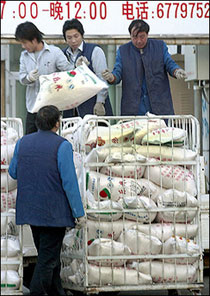The United Nations children's fund urged China to take a simple and cheap
step to reducing problems such as anemia and facial clefts in kids -- by
fortifying wheat flour.

Workers unload the
bags of flour from a truck, outside a supermarket in Beijing. The United
Nations children's fund urged China to take a simple and cheap step to
reducing problems such as anemia and facial clefts in kids -- by
fortifying wheat flour.[AFP/File] |
A senior
UNICEF official said China, as one of the world's largest producers of wheat
flour, would greatly improve its children's health if it added nutrients and
minerals such as folic acid and iron to it.
"Lack of folic acid in the diet causes problems including a relatively high
number of birth defects such as spina bifida and cleft lip. China has a very
large number of this," said Alan Court, director of UNICEF's Programme Division.
"By adding folic acid to diet, especially through food, this problem can be
significantly reduced."
He was speaking to AFP on the sidelines of a two-day conference ending
Thursday organized by UNICEF and China-based agencies to persuade the government
to adopt universal fortification.
While China has made the most progress in the region on reducing
malnutrition, vitamin and mineral deficiencies are still widespread in the
world's most populous country, UNICEF said in a statement.
For example, 26 percent of all women aged between 15 and 45 and 32 percent of
all children under two are anemic due to iron deficiency, it said.
China also experiences the world's highest rate of neural tube defects, a
severe congenital disease causing mental and physical handicaps due to folate
deficiency, which affects thousands of children a year.
Flour is a staple food in 180 countries and millers in about 50 countries
fortify their flour with essential vitamins and minerals -- but not yet in
China, the world's largest consumer of wheat, according to UNICEF.
A global alliance of international organizations, such as UNICEF, and
industries, have set the goal of having 70 percent of the world's wheat flour
fortified by the end of 2008.
Current only about 30 percent is fortified, Court said.
China -- as well as Asia, which consumes nearly 40 percent of the world's
wheat -- are a key to reaching this goal, Court said.
"Only about five percent (of wheat flour consumed in Asia) is fortified now.
That's a very stark figure. That's something that could change and can change
very quickly," Court said.
Fortifying wheat flour with iron, folic acid and zinc will also help children
grow taller, healthier and stronger with better attention spans, he
said.